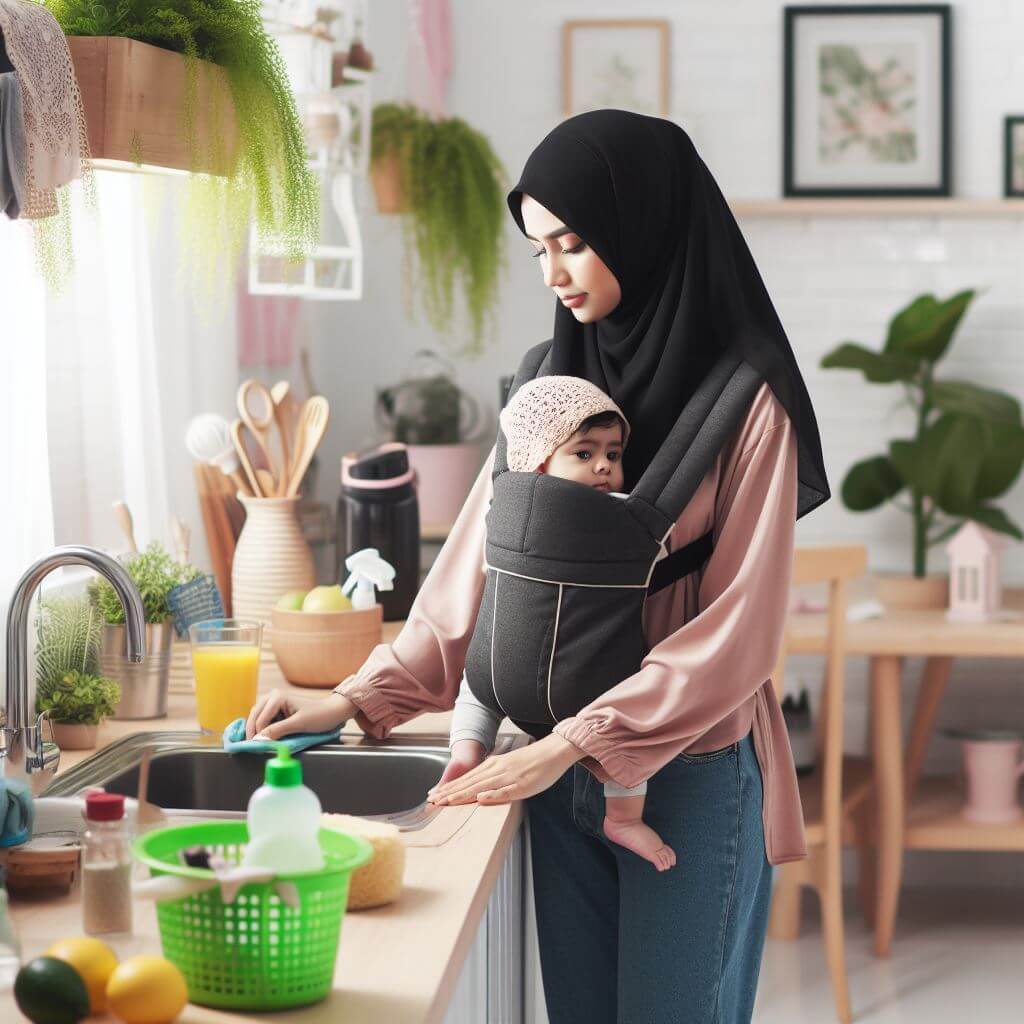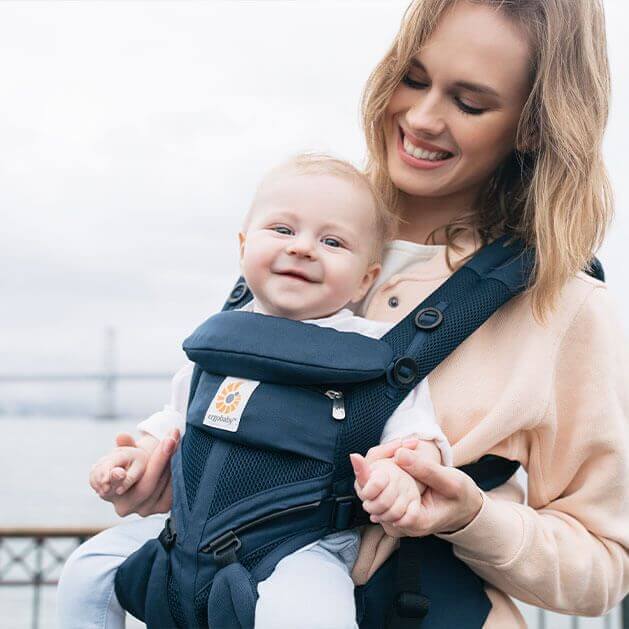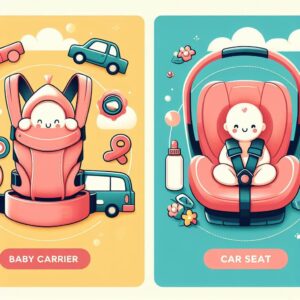Embarking on the journey of safe babywearing can be a beautiful bonding experience, but it often comes with questions and uncertainties, especially when it comes to the practicalities of how to carry a baby in a baby carrier.
Fear not, for in this blog post, we’re diving deep into the art of babywearing, providing you with comprehensive tips for choosing the right and wearing it the right way so that it is safe for your newborn baby.
From selecting the perfect baby carriers to mastering various carrying natural position and safety tips, I’ve got you covered. This guide will equip you with the knowledge and confidence for new or seasoned infant carriers to carry your baby close, safely, and comfortably.
Let’s explore the world of baby carriers together and embark on this magical journey of closeness and connection!
What is a Baby Carrier?

Baby carriers or baby slings are among parents’ loved equipment to carry their young babies on their chest or back. It is the most practical way to go about doing your daily tasks and house chores while keeping a close eye on your child.
Benefits of Using a Baby Carrier
The advantages of using a baby sling/carrier are numerous and often forgotten or overlooked.
Expose Baby to New Surroundings
First, let’s think back to when you were a baby, and the times when your parents put you in your stroller.
As a small child, when we sit in a stroller, all we can see are the people who pass by, and we don’t always get a good view of distracting sights. But when we get the privilege of being in a baby sling, we can see everything while we’re being carried.
This will keep a baby quiet and busy for quite some time, and they can enjoy the new sights.
Parents and Baby’s Bonding
Additionally, when you carry your baby in carriers, they tend to be a lot happier than when they are on the loose. This is because they are surrounded by their parents, and they feel safe.

When a baby is content, it can make the parent a happier person as well, and in better spirits to attend to any other children or jobs for the day.
And as an added benefit, you as a parent, will get chances to easily kiss their tiny faces, and breastfeed them easily (mothers).
Baby is Involved
Also, you can be more involved in household chores. You can get the dishes done, vacuum, and clean the counters, all while holding your baby in a carrier.

You can get more things done while holding the baby versus laying them down, which gives you more time to relax and spend with him or her.
Rather than leaving your infant crying, to be fussy, or to be put back in their stroller, a baby carrier is a great solution.
Choosing the right baby carrier
When choosing baby carriers, there are several important factors to consider:
- Safety
Ensure that the carrier provides proper support for the baby’s neck and back and that it has secure fastenings and buckles to keep the baby in place.
- Comfort
Look for a carrier with padded shoulder straps and a waist belt to distribute the baby’s weight evenly and reduce strain on the wearer’s back.
- Versatility
Consider how the carrier can be adjusted to accommodate different carrying positions such as front, back, and hip carries, as well as whether it can be used from infancy through toddlerhood.
- Breathability
Check if the carrier is made from breathable and lightweight materials to prevent overheating. Make sure to check if the fabric is gentle on the baby’s skin.
- Durability and Maintenance
Look for carriers made from high-quality, washable materials that can withstand regular use and washing. This is to ensure your carrier can withstand and be used for long periods.
- Baby’s Age and Development
Consider the age and developmental stage of your baby to choose a carrier that provides appropriate head and neck support.
- User Reviews
Research and read user reviews to gain insights into the experiences of other parents with the specific carrier you are considering.
Positioning your Baby
Positioning your baby correctly in a baby carrier is crucial for their safety, comfort, and healthy development. Follow these steps to ensure proper positioning:
Support the Baby’s Head
When placing your baby in the carrier, ensure that there is head support, as we don’t want accidental falls. For newborns, their head should be nestled close to your chest, with the baby’s face still visible and free from obstruction.
Maintain an Ergonomic Position
Position your baby in an ergonomic “M” shape, with their knees higher than their bottom and their thighs supported. This position promotes healthy hip development and prevents discomfort.
Check Spine Alignment
Your baby’s spine should maintain its natural curvature, forming a gentle “C” shape. Avoid forcing their spine into a straight position, as this can pose a greater risk of discomfort and strain.
Adjust Carrier Straps
Tighten the baby carrier’s straps to keep your baby snug against your body (baby’s face on your chest) while ensuring they have enough room to breathe comfortably. Make sure the carrier is securely fastened to prevent any risk of slipping or shifting.
Monitor Airway
Always ensure your baby’s airway remains clear and unobstructed. The baby’s chin should not be pressed tightly against the chest, as this can restrict breathing. Regularly check on your baby’s position to maintain proper airflow.
By following these guidelines, you can confidently position your baby in a baby carrier, providing them with a safe, comfortable, and enjoyable experience while keeping them close to you on your parenting journey.
How To Carry Baby In Baby Carrier
If you are still lagging and don’t get it, don’t worry! Trust me, I am a visual learner as well, that is why I’ve included a couple of videos that might be helpful for you mothers/ fathers who can follow along slowly to wear baby slings the right way.
These videos are simple, short, and straight to the point!
Traditional Baby Sling Wrap
The first video teaches the viewer the basic tie, a simple woven wrap is used in the video, demonstrating easy folds and twists to tuck in your newborn baby in a secure fit and an upright position.
Ergobaby The Omni 360 Baby Carrier
The second video is for the parents who enjoy hip-carrying and want their babies to face forward. It features an Ergobaby Omni 360 Carrier, a versatile carrier that allows you to carry your baby in various positions – front-inward, front-outward, hip, and back carries.
Conclusion

Babywearing is a beautiful way to create a strong bond with your baby while leaving your hands free for other tasks. By choosing the right carrier and learning how to carry your baby properly, you can ensure both you and your little one are safe, comfortable, and happy during this special time in their lives.
Remember, the best baby carriers are one that suits your lifestyle and meets your baby’s needs. So have fun exploring the different types of carriers and find the perfect fit for you and your little bundle of joy! Happy babywearing!
FAQ
How do I know if my baby is positioned correctly in the baby carrier?
Ensure your baby’s head is supported, and their face is visible and unobstructed. Check that their hips are in an ergonomic position with knees higher than their bottom.
Can I carry my newborn in baby carriers, and if so, what are the recommended positions?
Yes, you can carry your newborn in a baby carrier. For newborns, the recommended position is often facing inward, allowing them to snuggle close to your chest with proper head and neck support.
Some carriers also offer a newborn insert to ensure a snug and secure fit.
How do I adjust the baby carrier to fit both me and my baby comfortably?
Start by adjusting the carrier’s straps and waistband to fit snugly around your body. Ensure the carrier supports your baby’s weight evenly, with no pressure points or discomfort.
Experiment with different adjustments until you find the perfect fit for both you and your baby.
Are there specific safety guidelines I should follow when carrying my baby in baby carriers?
Yes, always follow the manufacturer’s instructions for proper use of the baby carrier. Check for any weight limits or age recommendations.
Regularly inspect the carrier for wear and tear, and ensure all buckles and straps are securely fastened before each use. Keep your baby’s airway clear and monitor their comfort throughout.





